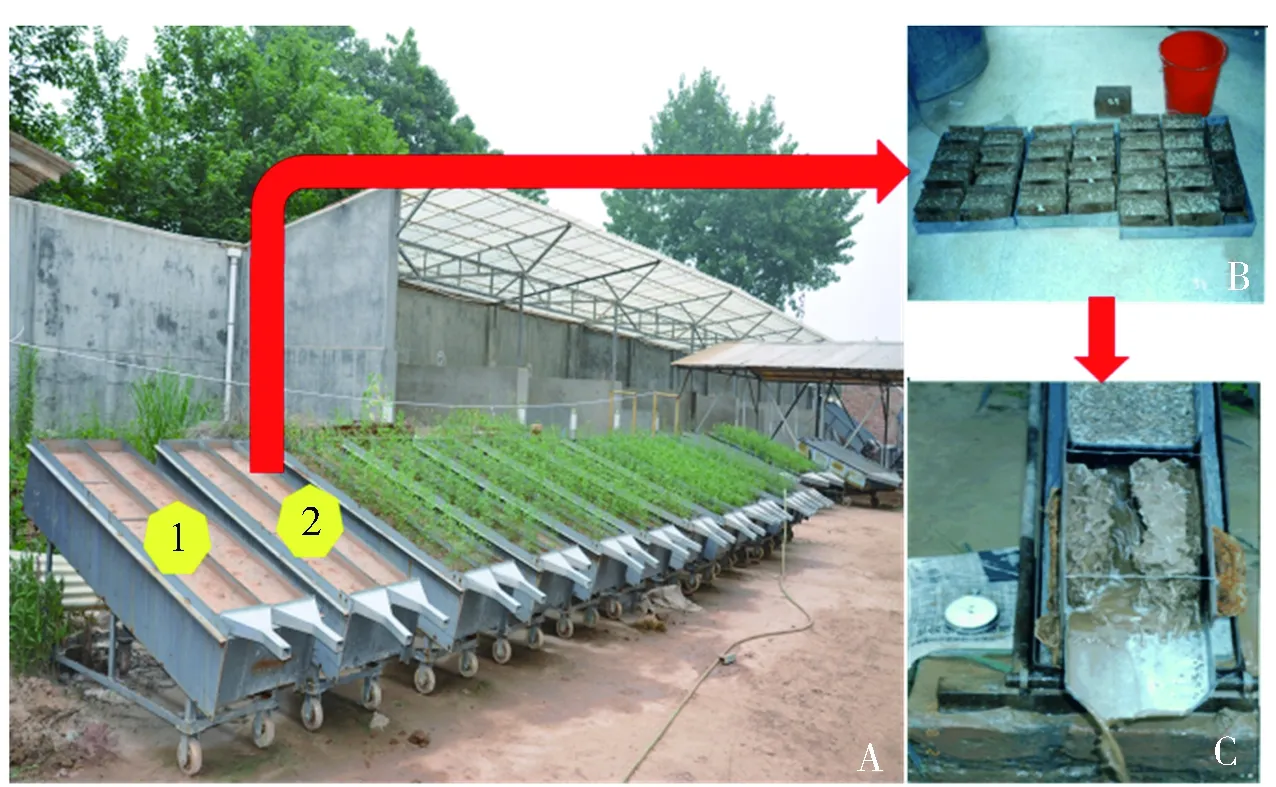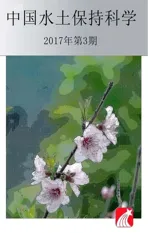黄土风沙区根系强化抗冲性土体构型的定量化研究
2017-07-05李强刘国彬张正马春艳白芸张晨晨
李强, 刘国彬, 张正, 马春艳, 白芸, 张晨晨
(1.榆林学院,719000,陕西榆林;2.陕西省陕北矿区生态修复重点实验室,719000,陕西榆林;3.西北农林科技大学水土保持研究所土壤侵蚀与旱作农业国家重点实验室,712100,陕西杨凌)
黄土风沙区根系强化抗冲性土体构型的定量化研究
李强1,2, 刘国彬2,3†, 张正3, 马春艳1,2, 白芸1,2, 张晨晨1,2
(1.榆林学院,719000,陕西榆林;2.陕西省陕北矿区生态修复重点实验室,719000,陕西榆林;3.西北农林科技大学水土保持研究所土壤侵蚀与旱作农业国家重点实验室,712100,陕西杨凌)
为了探明黄土风沙区根系网络串连、根土黏结及生物化学作用对于创造抗冲性土体构型的相对重要性,以沙黄土为研究对象,通过含根土壤、无根土壤及模拟根系土壤冲刷试验,分析了根系固土总效应、物理固结效应及生物化学效应等参数。结果表明:物理固结效应在根系总效应中的贡献值平均为70.9%;与苜蓿密度90株/m2相比,物理固结效应在处理360株/m2中增加了6.8%;在物理固结效应中,根系串连作用较为关键,平均占比78.2%;根系物理固结效应与根表面积密度在极显著水平(P<0.01)上呈指数递增函数关系。植物根系物理固结效应是强化沙黄土抗冲性土体构型的主要表现形式,且根表面积密度可较好地反映根系固土效应。
根系; 土壤抗冲性; 根表面积密度; 固土效应; 沙黄土; 黄土风沙区
早在20世纪60年代,朱显谟院士[1]依据黄土高原土壤侵蚀的特征指出,植被固土措施是水土保持中最有效和最根本的方法,并证实植被固土作用主要来源于根系的缠绕、固结和串连土体,使土体具有较高的水稳性结构和抗侵蚀强度,从而不易被径流带走。G. Gyssels等[2]以比利时壤土上的甜菜(BetavulgarisL.)、玉米(Zeamays)、菊苣(CichpriiIntybusL.)为对象,研究了不同生长期根系的固土效应,结果发现,根系可以最大减少20%的土壤流失量。而后,周正朝等[3]通过模拟降雨试验,观测了黑麦草(LoliumperenneL.)秸秆和根系对土壤侵蚀的影响,研究发现根系在减少土壤流失量中的贡献值可达96%。目前,在评价根系强化土壤抗冲性土体指标筛选方面取得了丰富的成果,先后有学者用单位土壤截面积上直径≤1 mm须根的数量[4]、1 000 cm3中直径在0.1~0.4 mm的根表面积[5]、单位土体中整个根系的表面积、以及根表面积密度等指标来表征根系对土壤稳定性的强化效能[6-8]。
与此同时,有研究[9-11]报道,植物根系通过串连土体、根土黏结,释放分泌物、多糖等胶结物质形式,改善土壤性质,从而创造较为稳定的土体构型。刘国彬[12]将根系的这些效能概况为根系物理固结(网络串连和根土粘结)和生物化学作用2类,并对根系强化抗冲型土体构型的相对重要性进行了较为系统的研究,结果发现根系物理固结效应在黄绵土上可达80%;但关于根系网络串连,根土黏结及生物化学作用对于创造抗冲性土体构型的相对重要性在沙黄土上鲜见报道,以及不同土壤类型上的差异一直没有得到印证。
因此,笔者以沙黄土为研究对象,通过含根土壤、无根土壤及专门设计的模拟根系冲刷试验, 定量分析根系网络串连,根土黏结及生物化学作用对于创造抗冲性土体构型的相对重要性,以期为黄土风沙区根系强化抗冲性土体构型提供理论解释。
1 研究区概况
本实验供试土壤采自中国科学院水利部水土保持研究所神木侵蚀与环境试验站的坡耕地(E 110° 22.043′,N 38° 47.723′),属大陆性季风气候。土壤类型为沙黄土,砂粒(2.00~0.05 mm)质量分数36.8%,粉粒(0.05~0.02 mm)51.2%,黏粒(<0.02 mm)12.0%。耕层土壤密度为1.35~1.45 g/cm3,pH值8.5~8.8,有机质质量分数2.0~3.5 g/kg。本研究的科学假设是距坡耕地地表以下2.5~3 m的黄土母质没有根系生物化学作用(如根系分泌物)的影响,作为无根土壤的对照1。农地表层0~25 cm土壤存在根系生物化学作用,但无物理固结效应,作为对照2。
2 材料与方法
2.1 实验设计与材料
野外土壤带回实验室,自然风干,将根系、碎石等杂质挑拣后过5 mm的土筛,按设计密度1.40 g/cm3分层填装土槽。试验土槽规格为长2 m,宽0.28 m,高0.3 m。其中,4个土槽自装槽后保持裸地状态(对照2)。土槽填土结束后,将表土平整使之与槽底平行,以保证实验条件的一致性。为了保持渗透均匀,土槽底部铺设一层5 cm的细沙。当装土全部结束后,在每一个土槽内的土壤表面平铺设一层细沙布,其上用洒水壶充分洒水后静置(图1)。为了便于模拟并获取不同根系密度的含根土样,选取了直根系的苜蓿(Medicagosativa),即待土壤潮湿而不黏结时按实验设计播种苜蓿草籽。本试验共设置了5个根系密度水平,4次重复,旨在通过增加根系密度处理,更易于反映根系固土功效与其密度之间的定量关系(表1)。黄土母质对照1和耕层土壤对照2各4个土槽,试验土槽共计24个。对照土槽在苜蓿生长期内及时清除休闲杂草。

A: 试验处理Experimental treatment diagram. B: 模拟根系Simulated roots in various densities. C: 冲刷过程Scouring process. 1: CK1. 2: CK2.图1 土壤冲刷装置及其过程Fig.1 Basic experimental set-up and process

表1 实验处理基本信息Tab.1 Basic information of experimental treatments
注:R1至R4分别代表根系密度水平1至水平4, 下同。 Note: R1 to R4 denote treatments of root density level 1 to 4, the same below.
试验苜蓿种植时间为2013年4月5日,将草籽称量等分,每份草籽与等量干土混合,按行距10 cm,沟深0.8 cm 撒播覆土种植。在植物生长后期(9月下旬)进行人工模拟根系的冲刷试验,即在对照1土槽内用特制取样器采集土样20个。选择与根系质地相近的绵线,作为模拟根系(直径0.4 mm),用特制的不锈钢针将绵线以与取样器水平面15°左右夹角轻轻穿入土中,绵线密度与根系设置密度一致。
2.2 模拟冲刷试验
将含有土样的取样器连同带孔铝制底片置于水面高度5 cm的水盘中,水从铝制底片自下而上浸润土壤12 h直至饱和。然后,将饱和的土样轻轻置于铁架台上8 h去除土壤重力水后进行抗冲实验。冲刷槽尺寸长2 m,宽 0.1 m,坡度15°,冲刷流量4.0 L/min,冲刷时间15 min[13]。自产流后的前3 min用集流桶每1 min收集1次径流样品,随后每2 min收集1次,共进行9次取样。冲刷结束后径流桶静置澄清,泥沙沉淀完全后倒掉上层清液,剩余泥水样转至铁盒内,置于烘箱中105 ℃烘干称量,测定泥沙质量(g)。
2.3 参数确定及方法
本文参数确定及方法参考刘国彬[12]研究成果:植物根系强化土壤抗冲性的总效应ARTE(root total effect, %)可分为物理固结效应BRPE(root physical consolidation effect,%)和生物化学效应CRBE(root biochemistry effect,%),其中,物理固结效应包括网络串连作用BNF(net function,%)和根土黏结作用BBF(bond function,%)。
1)根系总效应(ARTE),即含根土层相对于不含根黄土母质的土壤流失量。

(1)
式中:yCK1为黄土母质流失量;yi为不同根密度下土壤流失量(i= 1,2,3,4;下同)。
2)物理固结效应(BRPE),即含根土样相对于同一土层中无根土样的土壤流失量的比例。

(2)
式中yCK2为含根土层的土壤流失量。
3)网络串连效应(BNF),即含线土壤样品与不含线黄土母质的土壤流失量的比例。

(3)
式中y′i为不同模拟根系密度下土壤流失量。
由式(1)~(3)可以看出,在减沙效应计算中,为了实现数据的可比性,本文以根系的总效应值为基数,对上述数据进行了归一化处理,即假定根系总效应为100%,其他效应值的计算采用已有数据除以总效应值,进而获得根土黏结效应(式4)和根系生物化学效应(式5)。
4)根土黏结效应(BBF),即物理固结效应中除去根系网络串连效应部分。
BBF=BRPE-BNF。
(4)
5)生物化学效应(CRBE),指根系总效应中除去物理固结效应的部分。
CRBE=ARTE-BRPE。
(5)
3 结果与分析
3.1 根系及其密度对土壤性质的影响
植物根系生长能够对土壤学性质产生重要影响[14]。从表2可以看出,与处理CK2相比,含根处理土壤密度有所减小,最大减幅为6.9%。随着根系密度的增加(R1至R4),土壤团聚体含量呈增加趋势,增幅介于1.9~2.7倍之间。与对照CK2相比,土壤有机质、全氮和速效磷质量分数平均增加32.9%、66.7%和68.7%,这一结果说明含根土壤中植物根系能够改善土壤结构,提高土壤养分含量及其有效性[15-16]。土壤磷酸酶、脲酶、过氧化氢酶和蔗糖酶是生物学中表征土壤熟化程度的重要因子,可敏感地反映外界环境对土壤的干扰和影响[17]。从表2可以看出,与对照CK2相比,土壤磷酸酶、脲酶、过氧化氢酶和蔗糖酶呈显著增加,且随着根系密度的增加,其含量平均增加382.7%、16.8%、14.3%和288.0%。可见,植物根系不仅能够通过物理固结作用和生物化学作用活化土壤物理结构,提高土壤养分含量及其有效性,而且可促进土壤微生物活性。

表2 不同处理土壤基本性质Tab.2 Soil properties in different root-penetrated treatments
注:CK1 和 CK2 分别代表黄土母质、耕层土壤,同一列不同小写字母代表差异显著(P≤0.05)。Note: CK1 and CK2 denote the treatments of parent soil and tillage soil. Different small letters in the same column refer to difference significant atP≤0.05. BD, 土壤密度Bulk density; AC, 团聚体含量Aggregate content; SOM, 土壤有机质Soil organic matter; TN, 土壤全氮Total nitrogen;AP, 速效磷Available phosphorus; U, 脲酶Urease; P, 磷酸酶Phosphatase; S, 蔗糖酶Saccharase; C, 过氧化氢酶Catalase.
3.2 根系强化土壤抗冲性的相对重要性
由表3可以看出,根系在沙黄土上强化土壤抗冲性的物理固结效应贡献值为70.9%。随着根系密度的增加(R1~R4),与处理R1相比,处理R4的根系物理固结效应在根系总效应中的贡献值增加了6.8%。在根系物理固结效应中,随着根系密度增加(水平1~4),沙黄土中根系网络串连效应贡献值从70.7%增加至92.1%,平均贡献值78.2%。与此相比,刘国彬[12]研究发现,黄绵土中根系网络串连效应的相对贡献值随着根系密度增加而略有下降(降幅为5.7%),但根土黏结作用的相对重要性略有增加。这一结果说明根系减沙效应在壤土中较沙土优越,随着根系密度增加,沙黄土中根系网络串连作用越来越重要,而壤土中根土黏结效应的重要性有所增加。可见,根系物理固结效应是强化土壤抗冲性土体构型的主要表现形式,平均可占根系总效应的70.9%,且随着密度的增加,根系物理固结效应在强化土壤抗冲性土体构型中的贡献值越来越大。
3.3 根系强化土壤抗冲性土体构型的模拟方程
根表面积密度是指单位土体内植物根系的表面积大小,是评价根系生物学特征的重要参数。由图3可以看出,沙黄土中苜蓿根系物理固结效应与根表面积密度的关系可以用指数函数y=72.87(1-exp (-0.026x))较好地拟合,R2=0.89,这一结果说明根表面积密度能够较好地解释根系物理固结效应,进一步反映苜蓿根系的固土效应。

表3 根系强化土壤抗冲性构型的贡献值Tab.3 Relative contributions of root reinforcement to soil erosion resistance %

图3 根系物理固结效应与根表面积密度的关系Fig.3 Regression between root physical consolidation effect and root surface area density
4 结论与讨论
植物根系通过网络串连、根土黏结及生物化学作用能够强化抗冲性土体构型,但其作用方式及贡献在不同土壤类型上存在差异[5,18]。笔者选择黄土风沙区的沙黄土为研究对象,发现沙黄土中植物根系物理固结效应的贡献值占根系总效应的66.9%~73.7%,平均70.9%,与黄绵土相比,植物根系物理固结效应均是强化土壤抗冲性土体构型的主要表现形式,但其贡献值较黄绵土平均小9.1%。随着根系密度的增加(R1至R4处理),黄绵土和沙黄土中根系物理固结效应在总效应中的比例分别增大4.2%和6.8%。在物理固结效应中,沙黄土根系网络串连作用较为关键,而黄绵土根土黏结作用越来越重要[18]。产生这一结果的原因可能与壤土黏粒含量较大,保水性好、黏着力强、根土黏结作用较显著有关[19-20]。这一研究结果不仅可为不同土壤类型区根系强化抗冲性土体构型提供理论解释,而且对区域植被建设中水土保持物种选择标准,及其在不同土壤类型上的应用产生一定的指导意义。与此同时,本文研究结果发现,植物根系物理固结效应与根表面积密度之间的关系可以用指数递增函数y=72.87(1-exp (-0.026x))表达,R2=0.89,根表面积密度可较好地反映苜蓿根系的固土效应。这一研究结果与已有结果认为根系表面积密度与侵蚀减水减沙的相关性较好相吻合[21]。可见,植物根系物理固结效应是强化抗冲性土体构型的主要表现形式,且根表面积密度可较好地反映根系固土效应。鉴于此,在未来侵蚀区生态建设过程中植被物种的选择宜与土壤性质有效结合起来,充分发挥“以土定树、以土定草”的植被建设原则。
[1] 朱显谟. 黄土高原地区植被因素对于水土流失的影响[J]. 土壤学报, 1960, 8(2): 110. ZHU Xianmo. Effect of vegetation factor on soil and water loss in the Loess Plateau[J]. Acta Pedologica Sinica, 1960, 8(2): 110.
[2] GYSSELS G, Poesen J. The importance of plant root characteristics in controlling concentrated flow erosion rates[J]. Earth Surface Processes and Landforms, 2003, 28(4): 371.
[3] ZHOU Zhengchao, SHANGGUAN Zhouping. Effects of grazing on soil physical properties and soil erodibility in semiarid grassland of the northern Loess Plateau[J]. Catena, 2010, 82(2): 87.
[4] 李勇, 朱显谟, 田积莹. 黄土高原植物根系提高土壤抗冲性的有效性[J]. 科学通报, 1991, 36(12): 935. LI Yong, ZHU Xianmo, TIAN Jiying. The effectiveness of root reinforcement to flow-induced soil erosion on the Loess Plateau [J]. Chinese Science Bulletin, 1991, 36(12): 935.
[5] 刘国彬. 黄土高原草地土壤抗冲性及其机理研究[J]. 水土保持学报, 1998, 12(1): 93. LIU Guobin. Study on soil anti-scourability and its mechanism[J]. Journal of Soil and Water Conservation, 1998, 12(1): 93.
[6] De BAETS S, POESEN J, KNAPEN A, et al. Impact of root architecture on the erosion-reducing potential of roots during concentrated flow[J]. Earth Surface Process and Landforms, 2007, 32(9): 1323.
[7] TUO Dengfeng, XU Mingxiang, GAO Liqian. Changed surface roughness by wind erosion accelerates water erosion[J]. Jouranl of Soils and Sediments, 2016,16:105.
[8] YU Bofu, ZHANG Guanghui, FU Xudong. Transport capacity of overland flow with high sediment concentration[J]. Journal of Hydrology Engineer, 2015, 20(6): C4014001.
[9] ZHANG Chao, LIU Guobin, XUE Sha. Rhizosphere soil microbial properties on abandoned croplands in the Loess Plateau, China during vegetation succession[J]. European Journal of Soil Biology, 2012, 50: 127.
[10] ZUAZO V D, PLEGUEZUELO C R R. Soil-erosion and runoff prevention by plant covers: A review[J]. Agronmy for Sustainable Development, 2008, 28(1): 65.
[11] 吴林坤, 林向民, 林文雄. 根系分泌物介导下植物-土壤-微生物互作关系研究进展与展望[J]. 植物生态学报 2014, 38 (3): 298. WU Linkun, LIN Xiangmin, LIN Wenxiong. Advances and perspective in research on plant-soil-microbe interactions mediated by root exudates[J]. Chinese Journal of Plant Ecology, 2014, 38 (3): 298.
[12] 刘国彬.黄土高原草地土壤抗冲性及其机理研究[D]. 陕西杨凌: 中国科学院水利部水土保持研究所, 1996: 15. LIU Guobin. Research on soil resistance to erosion and its mechanism in the meadow on the Loess Plateau[D]. Yangling: Institute of Soil and Water Conservation, Chinese Academy of Sciences and Ministry of Water Resources. 1996: 15.
[13] ZHOU Zhengchao, SHANGGUAN Zhouping. The effects of ryegrass roots and shoots on loess erosion under simulated rainfall[J]. Catena, 2007, 70(3): 350.
[14] 鄂竟平. 中国水土流失与生态安全综合科学考察总结报告[J]. 中国水土保持, 2008, 12: 3. E Jingping. A summary report on soil and water loss, and ecological safety[J]. Soil and Water Conservation, China, 2008, 12: 3.
[15] 李建兴, 何丙辉, 谌芸, 等. 不同护坡草本植物的根系分布特征及其对土壤抗剪强度的影响[J]. 2013, 29(10): 144. LI Jianxing, HE Binghui, CHEN Yun, et al. Root distribution features of typical herb plants for slope protection and their effects on soil shear strength[J]. Transactions of the Chinese Society of Agricultural Engineering, 2013, 29(10): 144.
[16] 温维亮, 郭新宇, 赵春江, 等. 作物根系构型三维探测与重建方法研究进展[J]. 中国农业科学, 2015, 48(3): 436. WEN Weiliang, GUO Xinyu, ZHAO Chunjiang, et al. Crop roots configuration and visualization: a review [J]. Scientia Agricultura Sinica, 2015, 48(3): 436.
[17] LOADES K W, BENGOUGH A G, BRANSBY M F, et al. Effect of root age on the biomechanics of seminal and nodal roots of barley (Hordeum vulgare L.) in contrasting soil environments. Plant Soil, 2015, 395: 253.
[18] LI Qiang, LIU Guobin, ZHANG Zheng, et al. Relative contribution of root physical enlacing and biochemistrical exudates to soil erosion resistance in the Loess soil. Catena, 2017, 153: 61.
[19] BU Chongfeng, HAN Fengpeng. The combined effects of moss-dominated biocrusts and vegetationon erosion and soil moisture and implications for disturbance on the Loess Plateau, China. Plos One, 2015, 10(5): 1.
[20] 李强, 刘国彬, 许明祥, 等. 黄土丘陵区冻融对土壤抗冲性及相关物理性质的影响[J]. 农业工程学报, 2013, 29(17): 105. LI Qiang, LIU Guobin, XU Mingxiang, et al. Effect of seasonal freeze-thaw on soil anti-scouribility and its related physical property in hilly Loess Plateau[J]. Transactions of the Chinese Society of Agricultural Engineering, 2013, 29(17): 105.
[21] 郭明明,王文龙,史倩华,等. 黄土高塬沟壑区退耕地土壤抗冲性及其与影响因素的关系[J].农业工程学报,2016, 32(10): 129. GUO Mingming, WANG Wenlong, SHI Qianhua,et al. Soil anti-scourability of abandoned land and its relationship with influencing factors in Loess Plateau Gully region [J]. Transactions of the Chinese Society of Agricultural Engineering, 2016, 32(10): 129.
Quantitative studies on root reinforcement resisting flow-inducederosion in the sandy loess region
LI Qiang1,2, LIU Guobin2,3, ZHANG Zheng3, MA Chunyan1, 2, BAI Yun1, 2, ZHANG Chenchen1, 2
(1.Yulin University, 719000, Yulin, Shaanxi, China; 2.Shaanxi Key Laboratory of Ecological Restoration in Shaanbei Mining Area, 719000,Yulin, Shaanxi, China; 3.State Key Laboratory of Soil Erosion and Dry-land Farming on the Loess Plateau, Institute of Soil and WaterConservation, Northwest A&F University, 712100, Yangling, Shaanxi, China)
[Background] In semi-arid areas, soil erosion is a serious threat to land productivity and sustainability for natural and human-managed ecosystems. Traditional vegetation techniques are recognized as effectively in reducing soil erosion, whereas the most evident vegetation source that protects soil against erosion is root wedging, which is an important mechanism where roots can bind soil together and tie weak surface soil layers into strong and stable subsurface layers. Plant roots significantly affect soil erosion process of overland flow by physical consolidation (root link and root-soil adhesive) and biological chemistry functions. The purpose of this study was to evaluate the relative contributions of root link, root-soil adhesive as well as root biological chemistry functions to soil reinforcement. Such study could provide the theoretical explanation for root reinforcement resisting erosion in the flow-induced erosion regions. [Methods] For this purpose, a simulated scouring experiment was conducted on a sandy soil with sand content 36.8%, silt content 51.2% and clay content 12.0%. Three treatments considered were: 1) fallow (CK), 2) root-penetrated soil and 3) simulated-root-penetrated soil. Each treatment had four replicates. Rectangular, undisturbed soil samples (20 cm × 10 cm × 10 cm) were taken in the fallow and root pans and were conducted with a hydrological flume (2 m × 0.10 m). The flume contained an opening at its lower base, equaling the size of metal sampling box, so that the soil surface of soil sample was at the same level of the flume surface. Space between the sample box and the flume edges was sealed with painter’s mastic to prevent edge effects. The slope of the flume bottom could be varied and clear tap water flow was applied at 4.0 L/min rate discharge on a washing flume slope of 15° for 15 min. During the 15 minutes of each experiment, samples of runoff and detached soil were collected every 1 min in the first 3 min and 2 min in the following time using 10 L buckets for determining sedimentation. Therefore, this paper analyzed the relative role in creating the soil configuration of soil resistance to erosion quantitatively, using no root-penetrated soil, root-penetrated soil erosion simulation test. [Results] The results showed that the physical consolidation effect was the key role in soil erosion resistance, accounting for 70.9% in the total root effect. Compared with alfalfa density of 90 plants/m2, physical consolidation effect in the treatment of 360 plants/m2increased by 6.8%. In addition, the root string function was the key manner in a proportion of 78.2% in the physical consolidation effect. Exponential function well expressed the relationship between root physical consolidation effect and root surface area density (P<0.01). [Conclusions] Physical consolidation effect is the key role in soil erosion resistance, and root surface area density can reflect the root soil consolidation effect.
root; flow-induced erosion; root surface area density; solid soil effect; sandy loess; sandy loess region
2016-11-24
2017-03-28
项目名称: 国家自然科学基金“水蚀风蚀交错区沙柳根系固土抗侵蚀机理研究”(41661101);黄土高原土壤侵蚀与旱作农业国家重点实验室开放基金“电容法原位估测黄土区植物根系生物量的研究”(A314021402-1604)
李强(1986—),男,讲师。主要研究方向:土壤侵蚀及根系固土效应。 E-mail: qiangli@yulinu.edu.cn
†通信作者简介: 刘国彬(1958—),男,博士,研究员。主要研究方向:流域生态系统管理。E-mail: gbliu@ms.iswc.ac.cn
S157.1
A
2096-2673(2017)03-0099-06
10.16843/j.sswc.2017.03.013
